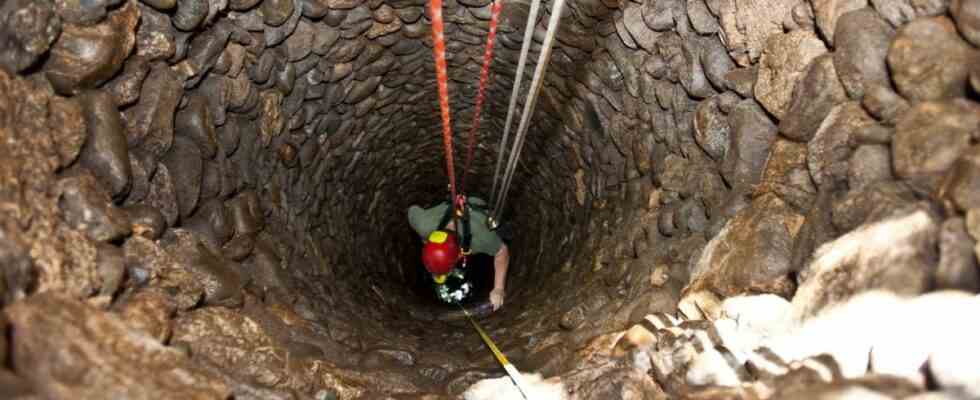Since the well was discovered in the Ebersberg Forest two years ago, its age and function have been hotly debated: was it used to quench the salt traders’ thirst or is it perhaps the entrance to the center of the earth? District home caretaker Thomas Warg prefers to stay on the ground – or the mud – of the facts, despite all the joy in speculation.
SZ: Mr. Warg, as a regional local curator and archeology fan – how much would you like to be roped down into this well?
Thomas Warg: Not at all! I would have had the opportunity, but I left that to others. I’m slowly getting older and wouldn’t have been of much use down there. In addition, it is not entirely safe to climb into the shaft, if only because of the questionable air quality.
Thomas Warg (left) wants to fathom the mystery of the forest fountain.
(Photo: Peter Hinz-Rosin)
Some people seem to be afraid of other things in this well.
As a matter of fact. There is speculation on social media that the infamous white woman resides in the well during the day…
Did you find her?
No, I have to disappoint you. It also doesn’t appear to be the entrance to the center of a hollow earth, as some have suggested, and we haven’t spotted any lizardmen either.
To put it bluntly, a well is a hole in the ground. Where does the fascination for this building come from?
The fountain is a kind of El Dorado in reverse: we are not looking for a mythical place that has an explanation and history, but we have a place and we are looking for its history. Of course, that fuels the imagination.
What interests you as a historian?
The discovery of the fountain raises many exciting questions: Who built this fountain, when and for whom – and why? If you look at the position of the fountain in the middle of the forest, it is initially illogical.
Why illogical?
Well, if you want to establish a settlement in the Bronze Age or in the Middle Ages, the first things you look for are three things: water, good soil, and hills to fortify. The Ebersberger forest has none of this, it is flat, the soil is not suitable for agriculture and water is usually only found at a depth of 40 meters. Nevertheless, someone decided to put a fountain here. And that fast! The fountain was completed in half a year, something like this often took several generations of master builders.
So why was the well dug there?
Various possibilities are conceivable, some more likely than others. The earliest document that mentions the well dates from 1739. At that time a forester may already have lived in the forest, but it is unlikely that a well was dug just for him. It’s a similar story with forest grazing, the driving of pigs into the woods so that they can eat their fill before winter sets in – but even for that, having your own well is almost too much. Some have also speculated that it was the Swedes who were in the area during the Thirty Years’ War, but that would have been too much effort. In addition, the fountain is probably much older.
Which explanation do you find convincing?
I assume that the fountain is older than Munich and was built by the monastery lords. After all, the forest belonged to them at that time. Before Munich was officially founded, the Salt Road, an important trade route, passed through the forest where the state road is today. It is quite possible that the well was used to bring water to the people on this route.
When was the fountain shut down?
That is hard to say. We know that it has been cleaned regularly for a long time because we have examined the silt that has accumulated at the bottom. We only found a few items there, so it seemed to have been in operation for a long time. It was last seen on a map in 1808, it was closed with a concrete slab in 1964 – then it fell into oblivion.
The silt at the bottom of the well contained few objects. This suggests that it was regularly cleaned.
(Photo: Christian Endt)
What’s next for the well?
There is much to do. On the one hand, dendrochronological investigations – i.e. determining the age of wood by counting annual rings – are to be carried out. The fountain was made using the fountain box method, parts of the box survive, as does the wooden shaft used to carry water to the top. The area around the well will also be examined. Where there is a well, there were usually other buildings, perhaps a courtyard or a small settlement.
Is this well the most exciting discovery of your career as a county homemaker?
Absolutely! Such a find is really rare, I’ve never heard of anything comparable. It’s not just any hole in the ground, the material is high-quality and well-preserved – that’s the Mercedes Benz of fountains.

